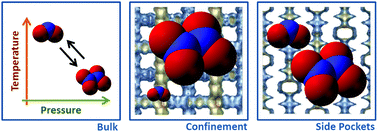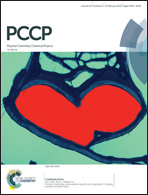Adsorption equilibrium of nitrogen dioxide in porous materials†
Abstract
The effect of confinement on the equilibrium reactive system containing nitrogen dioxide and dinitrogen tetroxide is studied by molecular simulation and the reactive Monte Carlo (RxMC) approach. The bulk-phase reaction was successfully reproduced and five all-silica zeolites (i.e. FAU, FER, MFI, MOR, and TON) with different topologies were selected to study their adoption behavior. Dinitrogen tetroxide showed a stronger affinity than nitrogen dioxide in all the zeolites due to size effects, but exclusive adsorption sites in MOR allowed the adsorption of nitrogen dioxide with no competition at these sites. From the study of the adsorption isotherms and isobars of the reacting mixture, confinement enhanced the formation of dimers over the full range of pressure and temperature, finding the largest deviations from bulk fractions at low temperature and high pressure. The channel size and shape of the zeolite have a noticeable influence on the dinitrogen tetroxide formation, being more important in MFI, closely followed by TON and MOR, and finally FER and FAU. Preferential adsorption sites in MOR lead to an unusually strong selective adsorption towards nitrogen dioxide, demonstrating that the topological structure has a crucial influence on the composition of the mixture and must be carefully considered in systems containing nitrogen dioxide.



 Please wait while we load your content...
Please wait while we load your content...